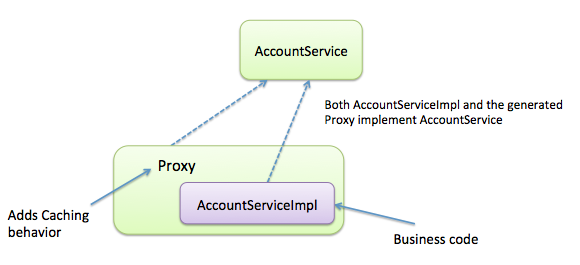Get ahead
VMware offers training and certification to turbo-charge your progress.
Learn moreIn the Spring framework, many technical features rely on proxy usage. We are going to go in depth on this topic using three examples: Transactions, Caching and Java Configuration.
All the code samples shown in this blog entry are available on my github account.
@Service
public class AccountServiceImpl implements AccountService {
//…
//Not specifying a transaction policy here!
public void create(Account account) {
entityManager.persist(account);
}
}
Since the method “create” is not transactional, it will most likely throw an exception (because this Account object should not be persisted outside of a transaction).
Here is what we have at runtime:

@Service
public class AccountServiceImpl implements AccountService {
@PersistenceContext
private EntityManager entityManager;
@Transactional
public void create(Account account) {
entityManager.persist(account);
}
}
And here is the corresponding Spring configuration:
<bean id="transactionManager">
<property name="entityManagerFactory" ref="entityManagerFactory" />
</bean>
<tx:annotation-driven/>
Inside Spring generic configuration, we have used <tx:annotation-driven /> . It means that all @Transactional annotations should be scanned at startup time and the targeted methods should become transactional. So where is the transactional behavior happening?
Before startup, we still have the same files as before:
At startup time, a new class is created, called proxy. This one is in charge of adding Transactional behavior as follows:
The generated proxy class comes on top of AccountServiceImpl. It adds Transactional behavior to it [1].
So how to make sure that a proxy is indeed being used? For your own understanding, it’s interesting to go back into the code and see with your very eyes that you are indeed using a proxy.
A simple way is to print out the class name:
AccountService accountService = (AccountService) applicationContext.getBean(AccountService.class);
String accountServiceClassName = accountService.getClass().getName();
logger.info(accountServiceClassName);
On my computer, it shows the following output:
INFO : transaction.TransactionProxyTest - $Proxy13
This class is a Dynamic Proxy, generated by Spring using the JDK Reflection API (more information here).
At shutdown (eg. When the application is stopped), the proxy class will be destroyed and you will only have AccountService and AccountServiceImpl on the file system:
@Controller public class AccountController { private AccountService accountService;
private void setAccountService(AccountService accountService) { this.accountService=accountService; }
//… }
<a href="http://blog.springsource.org/wp-content/uploads/2012/05/proxy-and-target1.png"><img class="aligncenter size-full wp-image-11128" title="proxy-and-target" src="http://blog.springsource.org/wp-content/uploads/2012/05/proxy-and-target1.png" alt="" width="316" height="255" /></a>
</div>
<div>
The attribute accountService is of type AccountService (interface). The variable dependency is on the interface type AccountService, not the implementation type, which reduces the coupling between classes. This is a best practice.
As seen before, both AccountServiceImpl and the generated Proxy implement the interface AccountService.
• If there is a proxy, Spring injects the proxy
• If not, Spring injects the instance of type AccountServiceImpl.
</div>
<h3><a name="cache">Caching</a></h3>
<div>
Declarative caching is a new feature in Spring 3.1 that works like Spring’s declarative transaction support.
The @Cacheable annotation should be used in that way:
</div>
<div>
```java
public class AccountServiceImpl implements AccountService {
@Cacheable(value="accounts", key="#id")
public Account findAccount (long id) {
// only enter method body if result is not in the cache already
}
}
You should also have enabled caching inside Spring configuration as follows:
<cache:annotation-driven />
Here are the expected results:
accountService.findAccount (1); // Result stored into cache for key “1”
accountService.findAccount (1); // Result retrieved from cache. Target method not called.
accountService.findAccount (2); // Result stored into cache for key “2”
At runtime, a proxy is used to add Caching behavior.
 Note: Spring 3.1 embeds a fairly simple cache implementation. It is usually recommended to use another implementation such as ehcache. On the sample application available here (https://github.com/michaelisvy/proxy-samples), you’ll find some examples using both the embedded cache implementation and ehcache.
Note: Spring 3.1 embeds a fairly simple cache implementation. It is usually recommended to use another implementation such as ehcache. On the sample application available here (https://github.com/michaelisvy/proxy-samples), you’ll find some examples using both the embedded cache implementation and ehcache.By default, if your bean does not implement an interface, Spring uses technical inheritance: at startup time, a new class is created. It inherits from your bean class and adds behavior in the child methods.
Note: this section requires some background knowledge of Java Configuration in Spring. Please feel free to skip it if you are not comfortable with this new configuration style.
You can learn more about Java Configuration here. There is also an excellent article which discusses the various configuration styles here.
@Configuration public class JavaConfig {
@Bean public AccountService accountService() {
return new AccountServiceImpl((accountRepository()); } @Bean public AccountRepository accountRepository () { //… }
}
Spring calls the method accountService() every time it needs to wire an instance of the bean “accountService” and this one returns a “new” object of type AccountService. If 10 beans are using a dependency of type AccountService, this method is called 10 times.
However, no matters the Spring configuration has been made using Java Configuration or not, every bean should be a singleton by default. How is that possible and where is the magic happening?
This diagram explains how things work internally:
</div>
<div><a href="http://blog.springsource.org/wp-content/uploads/2012/05/java-config.png"><img class="aligncenter size-full wp-image-11131" title="java-config" src="http://blog.springsource.org/wp-content/uploads/2012/05/java-config.png" alt="" width="507" height="328" /></a></div>
<div>
So the Proxy is adding behavior there. In the case that your bean should be a singleton, the action to turn your Plain Old Java Object into a singleton is performed by a child class (Proxy).
</div>
<div>
<h3>Conclusion</h3>
We’ve seen some use-cases on how proxies are used inside the Spring framework. There are many other examples: Aspect Oriented Programming, Security (using Spring Security), thread safety, scopes, etc…
If you would like to know more on the impact on performance when using proxies, you can read <a href="http://blog.springsource.org/2007/07/19/debunking-myths-proxies-impact-performance/">Alef Arendsen’s blog entry here</a>.
</div>
<div>
<hr size="1" />
<div><a name="note">[1]</a>to be exact: the proxy class does not contain the transaction code internally. It delegates transaction handling to some classes that are part of the Spring framework. Spring will then handle transactions according to the Transaction Manager you have declared.
</div>
</div>